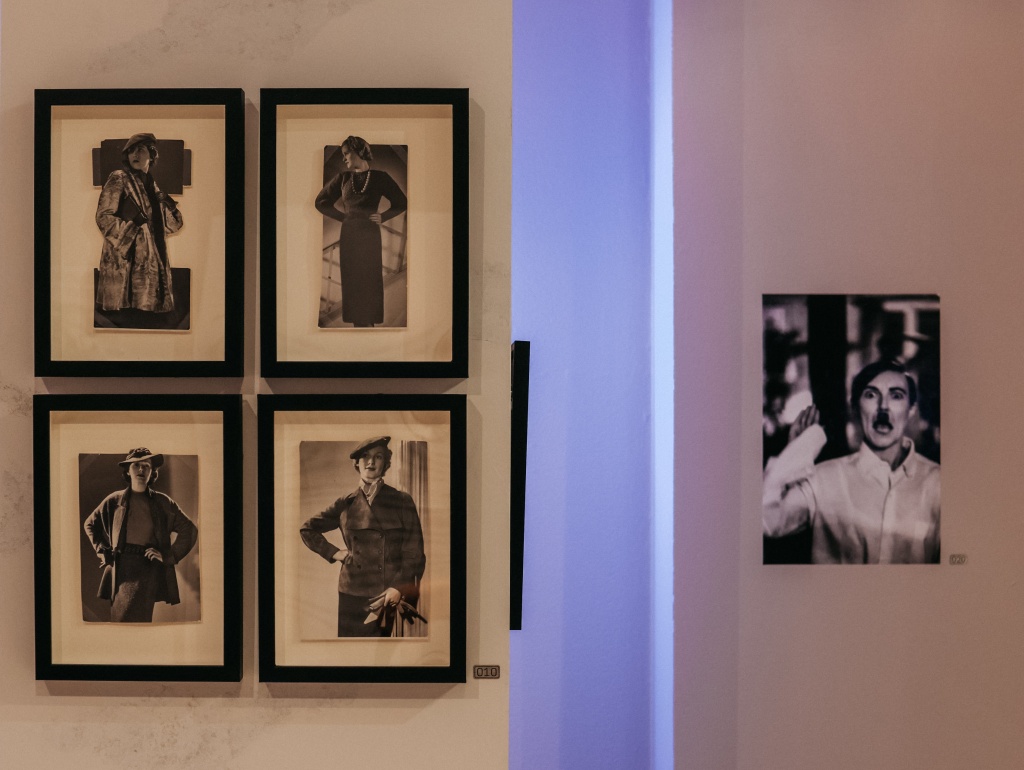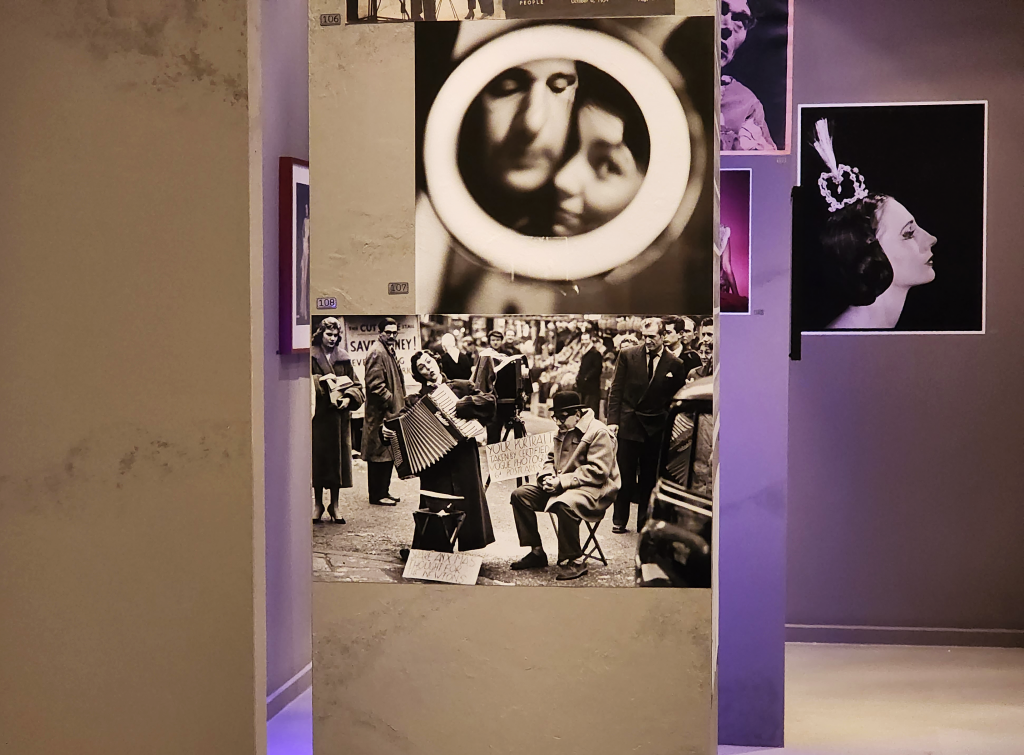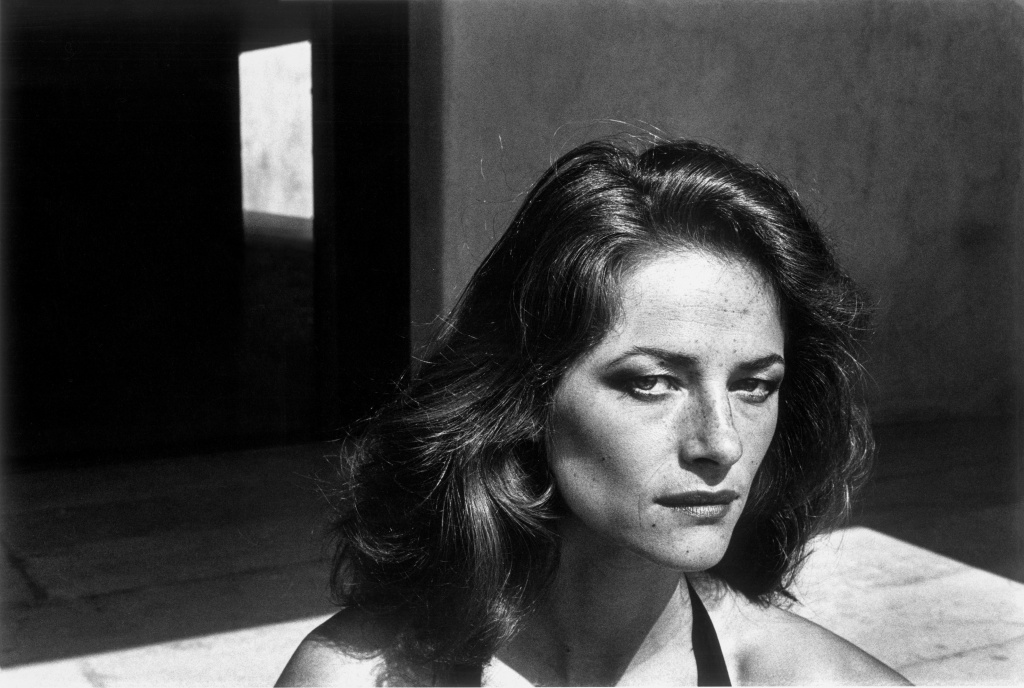Marie-Luise Skibbe, installation view of HELMUT NEWTON: In Focus (detail), Jewish Museum of Australia, Melbourne, 2022
To be completely honest, until recently I had not thought that much at all about Helmut Newton or his work. Having never studied photography at art school, I most likely fobbed him off as another ‘White Male Fashion Photographer’, working at the height of a celebrity-driven, high-roller boom, (which I was not at all interested in), fuelled primarily by capitalism.
The depiction of women in his work didn’t really register in a meaningful way for me until the time I cut my dark hair into a bob with a blunt fringe and started wearing red lipstick and pants with heels and as a result, more than a handful of people mentioned that I had a ‘bit of a Helmet Newton thing’ going on. It was unconscious, but I was ok with the reference. I remembered the women in his photos as tall, well-dressed (when they had clothes on) 80’s boss bitches, not unlike my own mother. But then there were also the timeless portraits burnt into my subconscious of Grace Jones, Raquel Welch and Sigourney Weaver… all women at the pinnacle of the icon triangle in my mind.

Helmut Newton, Sigourney Weaver on the Warner Bros. Lot, Burbank, 1983, copyright Helmut Newton Estate, courtesy Helmut Newton Foundation
Recently, I was asked to chair a discussion at the Wheeler Centre for PHOTO 2022, in association with the Jewish Museum of Australia’s landmark retrospective HELMUT NEWTON: In Focus, with contemporary photographers Atong Atem, Shannon May Powell and James J. Robinson. In preparation for the talk, I visited the exhibition at the Jewish Museum and immediately realised I was actually extremely interested in one aspect of Newton’s life, about which I had no prior knowledge—his wife.
As a long-term partner of a powerful white man myself, I am acutely aware of all the amazing, creative female partners (and muses) throughout history who have faded into the shadows of their (often less talented) male counterparts. My interest in June Newton was immediately piqued.
Her presence is direct and hilarious—holding the male gaze and challenging it.
One of the first images in the show (Alice Springs, Ramateulle, 1962) depicts June sporting a Hitler moustache and extra dark, raised eyebrows, her right hand in the pose of a ‘Sieg Heil’ salute. Her white bra visible through an oversized, white, man’s shirt, cuff partially covering her hand, she looks both funny and fierce. But hang on a second, I thought, wasn’t Newton Jewish? This led me to immediately realise that this woman was something else. Something more than a mere muse. She was challenging and humorous, who was she?

Marie-Luise Skibbe, installation view of HELMUT NEWTON: In Focus (detail), Jewish Museum of Australia, Melbourne, 2022
Interestingly, a lot of the 80s feminist criticism (for example, Susan Sontag and Laura Mulvey who both discuss the male gaze) surrounding Newton’s depiction of women reference his mimicking of Nazi propaganda, his publicly declared love of Leni Riefenstahl’s work, and his general modus operandi ‘to take part in a sexual theatre, a staging of sexuality’ (according to Sontag in ‘Fascinating Fascism’, New York Review of Books, 1974) and his obsession with the depiction of powerful-looking women, as supposedly some kind of fascist agenda.
However, that’s not how I see this image at all. I see it as playful, performative and comical–radical even. Her presence is direct and hilarious—holding the male gaze and challenging it. The effect is the ultimate antidote to fascism and misogyny and very much has the feeling that the shot was her idea. But who knows what goes on behind the camera, perhaps it was both of their ideas. Maybe they were drunk and just mucking around.
The thing I find most interesting about June was that she went on to not only appear in many of Newton’s photographs as his muse, but she eventually picked up the camera and became a master herself.
Born June Browne in Melbourne in 1923, she began the first part of her career under the name June Brunell—primarily as an actress. Story has it that June took up the camera when Helmut fell ill in 1970 and had a commercial shoot that couldn’t be cancelled. June chose the pseudonym Alice Springs, (which I immediately registered as some kind of incredible drag performer’s name), to be her name as a photographer.
She is quoted on the Machonchie Photography website (the gallery who represent her estate) relating the story of her new name: ‘It was during dinner one evening just before the first publication of my photographs that Helmut asked me what name I intended to use. Jean Seberg and her Spanish boyfriend, Ricardo, were among the guests and Ricardo asked for an atlas which I produced. He opened it to the map of Australia, asked for a pin, told me to shut my eyes and aim. The pin landed at the centre of The Continent-Alice Springs. “There’s your name”, he said.’
To me, after spending a little bit of time with their pictures, and reading between the lines and the shadows, it seems that’s exactly what June was—the rock at the centre of Helmut Newton and his success.
The Jewish Museum shows an early, fascinating excerpt from People magazine titled ‘High Fashion Photographer: Helmut Newton forever hunts new faces’ (October 6, 1954 p.17) The article starts: Helmut Newton, ace fashion photographer of Melbourne and his lovely actress wife June Brunell have a habit of staring at passers-by as they stroll through the city streets. Often the earnest stares are followed by what Helmut calls ‘the dirty work’ which he usually leaves to June. This “dirty work” is an invitation to an interesting face to come and be photographed in Helmut’s studio with a view to fashion modelling.
For me, this created a mental picture of a performative collaboration. This comedic, charming woman ‘hunts’ the talent and he, takes the pictures. Seen through a contemporary lens, this is very much a shared gaze rather than a purely male one.

Sarah Giles, installation view of HELMUT NEWTON: In Focus, Jewish Museum of Australia, Melbourne, 2022
Another image that fascinates me is of June and Helmut taken by Claude Virgin in 1956 at Piccadilly Circus. The two of them seem to be busking, with June on the piano accordion and Helmut sitting in a chair by her side with a handwritten sign reading ‘Your Portrait Taken by Certified Vogue Photographer-6c Postcards.’ Were they really that broke that they needed to busk on the street? Or is this a glimpse at the two-man show that was Helmut and June?
Other images from the exhibition that feature June include ‘Self portrait with wife and models’ (Paris 1981) where we see Helmut reflected in the mirror beside a statuesque woman wearing only high heels: him diligently bent over his camera with June sitting to the right of the mirror, facing both the model and the camera. She looks half bored, half deep in thought, wearing glasses, head in hand, legs crossed, totally comfortable facing her husband and a naked woman. Is it a coincidence that she is sitting in a director’s chair? Is her involvement more than just as an observer? We can really only speculate, as history will always preserve the master as the sole genius, despite obvious clues that others were involved.
Both these images suggest that June was not just a bystander in Helmut’s life and career, but a performative and editorial force. This is echoed in a memorial statement for June Newton on the Taschen Books website: ‘When we [Taschen] first met Helmut and June Newton in the 1990s, it quickly became clear that June was so much more than Helmut’s wife. She was his alter ego, his creative partner in life and in business, his muse, his best friend and critic, and of course, the editor of Helmut Newton SUMO.’
The fact that this woman was his wife makes me somehow see him differently and like him more. It’s funny, even though many female photographers find his gaze to be objectifying and demoralising, I still don’t see his work like that. I see it as sexy and exciting, sometimes even comical. Interestingly, when I posted about the panel I was hosting on my Instagram quite a few vocal feminist friends piped up, saying that Helmut Newton was ‘perpetuating a predatory male gaze,’ and ‘one of my least favourite photographers,’ and was ‘championing unrealistic female body image.’
But one of the most interesting insights came from a well-known female photographer friend of mine (born in Australia but now based in Berlin) Lyndal Walker: ‘I used to really dislike his work and then found myself musing about how I’d like to be represented if I was nude in a photo. He immediately sprung to mind and since then I’ve let myself enjoy his work and engage in the provocation rather than just read it within the 80’s feminism I originally approached it with. My attitude has also developed since I’ve lived in Berlin where attitudes to both nudity and sexuality are so much more open. Seeing the enormous prints of his work ‘They’re Coming’ above the staircase of his museum in Berlin is amazing. The models do really look very powerful despite their nudity. I find it a very inspiring image.’
It seems to me, very clear, that Helmut not only liked strong women as he claimed, he was ultimately influenced, perhaps even possessed by them and their power… he was under the spell of strong women.
This also made me think of actress Charlotte Rampling’s powerful testimonial. She talks about Newton taking her first nude picture in the documentary from 2020 The Bad and the Beautiful. She says, ‘I could all of a sudden see who I was’.

Helmut Newton, Charlotte Rampling, St. Tropez, 1976, copyright Helmut Newton Estate, courtesy Helmut Newton Foundation
Perhaps as women, some of us want to be seen as towering, sexual and powerful. Perhaps we are finally allowed to see ourselves as whatever we want, regardless of our gender. Maybe Newton was a conduit for both female and male desire and in this sense, way ahead of his time.
It seems to me, very clear, that Helmut not only liked strong women as he claimed, but was ultimately influenced, perhaps even possessed by them and their power. From his very early days of assisting famous Weimar studio photographer Else Ernestine Neuländer-Simon (known as Yva) to his relationship and life with June/Alice Springs, to the many powerful women he photographed, he was under the spell of strong women.
He said himself in the 1995 film, Helmut by June: ‘I’ve always liked strong women because I feel secure. I’m not very strong […] if I have a strong woman with me, like a June—she’s a real Aussie— she’s strong when she needs to be strong, but she’s also strong in the head.’
Those of us who are strong in the head are often sexually confident too. Having to hide our bodies in order to negate objectification is ultimately regressive. Helmut worshiped women (June most of all) and I believe his photos show strong women who are not afraid to be naked, powerful and free.
—
Tai Snaith is an artist, author and broadcaster living and working on unceded Wurundjeri land. Her multi-disciplinary work celebrates the intersection of stories, collections, people and place. She is interested in how objects like books, vessels and other utilitarian items can be powerful tools to illustrate the times we live in as well as the past. How like literature, objects can convey a deep emotional point of view. Tai has artwork held in both private and public collections including Artbank, City of Banyule, NGA and State Library of Victoria as well as recently commissioned series for Andaz Prague. Tai has a podcast of conversations called A World of One’s Own originally commissioned by ACCA, which is now in its third season.
This essay was originally published in Issue #2 of ILLUMINATE.
